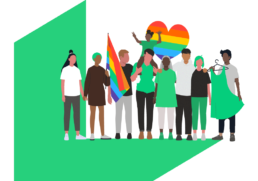
LGBTQ+ Inclusion Toolkit
LGBTQ+ Inclusion Toolkit
Toolkit collated by Bethan Hughes and Holly Parker-Guest with Jo Brassington
What Is LGBTQ+ Inclusion?
- Lesbian
- Gay
- Bisexual
- Transgender
- Queer (sometimes Questioning)
- The plus allows space for a vast spectrum of sexual and/or romantic orientations, as well as gender identities. This includes: Intersex, Asexual, Aromantic, Non-Binary, Pansexual, and other language that people use to identify and meaningfully talk about their experience.
Since the 1990’s there has been significant progress in some areas of LGBTQ+ rights within the UK: from same sex marriage being made legal, to introducing the world’s first transgender action plan in 2011. More recently, we’ve seen positive progress within education: from the inclusion of LGBT+ relationships in compulsory Relationships and Sex Education, to the introduction of LGBT+ young people in the statutory safeguarding guidance Keeping Children Safe In Education.
It is important that we are creating inclusive educational environments where all students feel safe and represented – and this must include LGBTQ+ students. However, there is still much work to do to create LGBT+ inclusive educational spaces.
- Nearly half of LGBT pupils (45 per cent) – including 64 per cent of trans pupils – are bullied for being LGBT in Britain’s schools. This is down from 55 per cent of lesbian, gay and bi pupils who experienced bullying because of their sexual orientation in 2012 and 65 per cent in 2007
- Half of LGBT pupils hear homophobic slurs ‘frequently’ or ‘often’ at school, down from seven in 10 in 2012
- Seven in 10 LGBT pupils report that their school says that homophobic and biphobic bullying is wrong, up from half in 2012 and a quarter in 2007. However, just two in five LGBT pupils report that their schools say that transphobic bullying is wrong
- Just one in five LGBT pupils have been taught about safe sex in relation to same-sex relationships
- More than four in five trans young people have self-harmed, as have three in five lesbian, gay and bi young people who aren’t trans
- More than two in five trans young people have attempted to take their own life, and one in five lesbian, gay and bi students who aren’t trans have done the same
More recent evidence from the 2021 Just Like Us ‘Growing Up LGBT+ Report’ found that LGBT+ young people were twice as likely to be lonely or worried daily about their mental health. Furthermore, a large-scale pupil safeguarding survey conducted in 2023 by The Key found that LGBT+ young people feel considerably less safe in school than their counterparts.
It has been proven that providing an LGBTQ+ inclusive education reduces incidents of homophobic, biphobic and transphobic bullying as well as improving the mental wellbeing of LGBTQ+ youths. Ensuring that education is LGBTQ+ inclusive is imperative as attitudes learnt at school go with that young person into the world, the workplace and the wider community. Everyone (LGBTQ+ or not) benefits from a more inclusive education.
The Diverse Educators’ LGBTQ+ Inclusion Toolkit
We are collating a growing bank of resources to support you to be able to stand up, speak up and celebrate members of the LGBTQ+ community in your school.
- How can we avoid LGBTQ+ discrimination in our schools?
- How can I encourage all school staff to understand the benefits of LGBTQ+ inclusion?
- How do I challenge LGBTQ+ discrimination-based language and incidents?
- How do I support LGBTQ+ students to share their identity in our schools, if they choose to?
- How can we create an LGBTQ+ inclusive culture and ethos in our schools?
What Does Good LGBTQ+ Inclusion Look Like?
- Bullying and use of derogatory language is consistently challenged
- Gender neutral language is used across the school and in policies
- Stereotypes are challenged – in the curriculum, in policies and in conversations
- An inclusive curriculum where LGBTQ+ identities are embedded – not just stand-alone lessons
- Diverse LGBTQ+ role models are visible
- Staff need to have the training and the confidence to know how to support LGBTQ+ young people
- Also, don’t underestimate visibility of LGBTQ+ members of staff and the impact of seeing them treated well. If students can see their teachers thriving then they are more likely to see how they can thrive too.
If, as educator we can create LGBTQ+ inclusive educational spaces, then we are not only setting young people up for success in our schools, but in society too.

